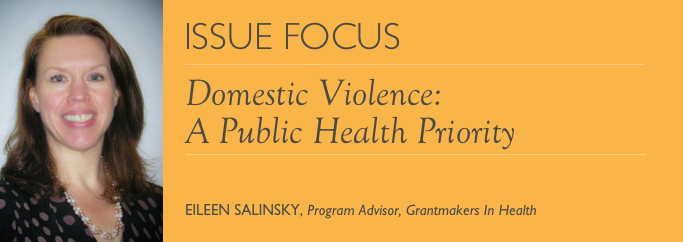July 2017

| Domestic violence, also referred to as intimate partner violence, describes physical violence, sexual violence, stalking, or psychological aggression by a current or former intimate partner. Intimate partners include spouses, boyfriends, girlfriends, dating partners, or sexual partners in both heterosexual and same-sex relationships. |
Domestic violence represents a significant public health problem that has received limited attention from the field of health philanthropy. Many health foundations fund domestic violence programs, but relatively few funders have identified domestic violence as a strategic priority. With some notable exceptions, such as the Blue Shield of California Foundation, funders allocate a relatively small proportion of their grantmaking budgets to domestic violence. A Foundation Center study of foundation funding for domestic violence in California found that just 0.4 percent of foundation grants awarded to California-based organizations are allocated to domestic violence intervention and prevention (Henry-Sanchez and Mukai 2014).
Why should health foundations increase their attention to domestic violence? Domestic violence affects a shockingly large proportion of the population and has a profound influence on the health and wellbeing of victims and their families. Perhaps most importantly, the underlying causes of domestic violence are complex and deeply entrenched, requiring the types of creative solutions philanthropy is uniquely well suited to advance.
Prevalence
Domestic violence is widely prevalent. More than one in three women in the United States (37 percent) and more than one in four men (31 percent) experience sexual violence, physical violence, or stalking perpetrated by an intimate partner during their lifetime (Smith et al. 2017). Psychological aggression is even more common, with nearly half of all women (47 percent) and men (47 percent) reporting psychological aggression by an intimate partner during their lifetime. Domestic violence occurs in families at all income levels, but low income households are more likely to report experiencing domestic violence than affluent households.
Women are much more likely than men to experience intimate partner violence that has a significant impact on their lives (e.g., violence resulting in fear, injury, or need for services). During their lifetime, 27 percent of women experience sexual violence, physical violence, or stalking at the hands of an intimate partner that results in an impact compared to 11 percent of men.
Prevalence of Intimate Partner Violence Victimization
| Women | Men | |||
| Lifetime | 12 month | Lifetime | 12 month | |
| Sexual Violence, Physical Violence, and/or Stalking with Impact | 27% | 5% | 11% | 2% |
| Sexual Violence, Physical Violence, and/or Stalking | 37 % | 7% | 31% | 6% |
| Sexual Violence | 16 % | 2 % | 7% | 2 % |
| Physical Violence | 32% | 4% | 28% | 5% |
| Stalking | 10 % | 3% | 2% | 1% |
| Psychological Aggression | 47 % | 14% | 47% | 18% |
Source: The National Intimate Partner and Sexual Violence Survey (NISVS): 2010-2012 State Report. Atlanta, GA: National Center for Injury Prevention and Control, Centers for Disease Control and Prevention, 2017. Data rounded to the nearest whole number.
Consequences
Domestic violence has a profound effect on the health and well-being of victimized individuals. Approximately 13 percent of women and 4 percent of men have been physically injured as a result of domestic violence during their lifetime. (Breiding et al. 2014). Nearly 40 percent of all female homicide victims are killed by an intimate partner (Catalano 2013). In addition to the immediate physical injuries and fatalities suffered by victims, exposure to domestic violence is also associated with long term adverse health outcomes. Women with a history of domestic violence are more than three times as likely as non-abused women to have a mental health condition, and they are more likely to experience sexually transmitted diseases, unintended pregnancy, and poor pregnancy outcomes (Chibber, Cantor, and Greenberg 2016). Abused women are also more likely than non-abused women to engage in high risk behaviors, such as smoking and substance use disorders. Furthermore, the chronic stress caused by domestic violence is linked to higher rates of chronic diseases (such as heart disease and diabetes) for abused women.
Children exposed to domestic violence also experience negative health consequences in both the short- and long-term. Children whose mothers were victims of domestic violence have higher rates of emergency department, primary care, and mental health service utilization than children whose mothers did not experience abuse. Domestic violence and child abuse are often co-occurring. Children experience physical abuse in an estimated 40 percent of households affected by domestic violence (Appel and Holden 1998). Adverse childhood experiences, including witnessing domestic violence, are strongly correlated with health risk behaviors and chronic disease outcomes later in life. Witnessing domestic violence during childhood also increases the risks of adult victimization, perpetration, and criminal activity.
Prevention and Intervention—The Role of Funders
The Centers for Disease Control and Prevention has identified four major types of activities to prevent and intervene in domestic violence:
- promoting healthy family relationships,
- providing coordinated services to domestic violence victims,
- enforcing laws to hold perpetrators responsible, and
- conducting research and data collection to monitor trends in domestic violence and evaluate the effectiveness of prevention and evaluation efforts.
The federal government is the major source of funding for efforts to prevent and address domestic violence, but philanthropy has played an important role in supporting domestic violence services.
Philanthropic funding to address domestic violence is largely devoted to direct services for victims and their families, such as housing assistance, counseling, legal aid, and health care. Some funders provide general operating support to organizations that provide services to victims of domestic violence. However, foundation grants for domestic violence services more typically fund specific projects or programs designed to enhance the scope, reach, or effectiveness of these services. Examples of this work include efforts to:
- Develop Culturally Responsive Services: Social and cultural factors affect whether and how victims of domestic violence disclose abuse and may influence the effectiveness of the services they receive. Domestic service providers are most successful when they adapt interventions to the cultural perspectives of the people they serve. Cultural competence requires the provision of both linguistically and culturally sensitive services. In 2012, the Blue Shield of California Foundation funded a $2.6 million program to strengthen cultural competency in California’s domestic violence field with a focus on outreach to Tribal communities, African Americans, and recent immigrant populations. Grants supported a broad range of activities, including organizational assessments, training for staff, outreach to target communities, and diversification of staff and service entry points.
- Increase Economic Self-Sufficiency of Survivors: Economic concerns can be a key hurdle preventing victims from leaving abusive relationships. In addition to providing shelter and healing services, domestic violence agencies often seek to help victims achieve economic independence. The Robert Wood Johnson Foundation funded Manavi, a New Brunswick, New Jersey-based nonprofit, to develop and deliver empowerment tools that help South Asian women who are survivors of domestic violence secure employment and educational opportunities. The tools include a needs assessment, training and education options, resume building and job search strategies, an inventory of community and online resources, information on the legal rights of persons seeking employment in the United States, and a training curriculum focused on interview skills.
- Raise Awareness and Response Capacity among Health Care Providers: Health care providers can play a pivotal role in identifying families affected by domestic violence and connecting victims to intervention services. Unfortunately, deficiencies in training, screening protocols, and referral policies may prevent health care providers from recognizing and intervening in cases of domestic abuse. The Duke Endowment granted more than $9.5 million between 2000 and 2005 to help hospitals respond more effectively to domestic violence. Primary objectives for grant activities included training providers to recognize signs of abuse, improving the collection of forensic evidence that can be used to prosecute offenders, and building partnerships with community agencies to facilitate referrals for intervention services.
Although most philanthropic funding for domestic violence is focused on intervention, health foundations are also making investments in prevention. For example, the Kansas Health Foundation recently funded St. John the Evangelist Catholic Church to prevent domestic violence among Latino families. The program provides increased case management support and linkages to community resources for at-risk families, such as access to healthcare, early childhood education, housing assistance, mental health services and psychoeducational groups. The Blue Shield of California Foundation has partnered with the California Department of Public Health to develop and test a teen dating violence prevention model in rural and urban communities. The program, Close to Home, cultivates youth leadership to mobilize communities and change social norms related to the creation and maintenance of healthy relationships.
Prevention efforts are challenging because the causal factors perpetuating domestic violence are complex and, in some ways, not fully understood. Risk factors include:
- individual characteristics (e.g., young age, poverty, stress, mental health and substance use disorders, history of childhood abuse, history of witnessing parental domestic violence, history of prior abuse by an intimate partner),
- relationship dynamics (e.g., levels of conflict, control, and dominance), and
- social norms (e.g., acceptance of violence, weak sanctions against abuse, gender inequity).
The intergenerational and societal nature of domestic violence blurs distinctions between intervention and prevention and calls for a sustained, multi-faceted response.
Philanthropy has a key role to play in cultivating innovative ways to help victims escape abusive relationships and mitigate the numerous risk factors related to domestic violence. More work is needed to improve the effectiveness of domestic violence services, develop and evaluate new prevention models, and advocate for policy change to strengthen the public sector’s capacity to address domestic violence.
References
Appel, Anne, and George Holden. 1998. The Co-Occurrence of Spouse and Physical Child Abuse: A Review and Appraisal Journal of Family Psychology 12 (4):578-599.
Breiding, M. J., S. G. Smith, K. C. Basile, M. L. Walters, J. Chen, and M. T. Merrick. 2014. Prevalence and characteristics of sexual violence, stalking, and intimate partner violence victimization–national intimate partner and sexual violence survey, United States, 2011. MMWR Surveill Summ 63 (8):1-18.
Catalano, Shannan. 2013. Intimate Partner Violence: Attributes of Victimization, 1993–2011. U.S. Department of Justice, Office of Justice Programs, Bureau of Justice Statistics.
Chibber, Karuna, Jeremy Cantor, and Eliana Greenberg. 2016. Domestic Violence Literature Review: Analysis Report. JSI Research and Training Institute, Inc.
Henry-Sanchez, Brenda, and Reina Mukai. 2014. Foundation Funding to Address Domestic Violence in California. Foundation Center.
Smith, S.G., J. Chen, K.C. Basile, L.K. Gilbert, M.T. Merrick, N. Patel, M. Walling, and A. Jain. 2017. The National Intimate Partner and Sexual Violence Survey (NISVS): 2010-2012 State Report. Atlanta, GA: National Center for Injury Prevention and Control, Centers for Disease Control and Prevention.
Focus Areas:
Topics:

